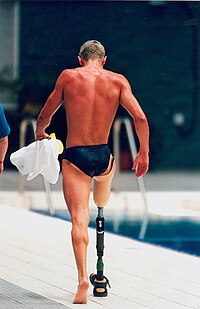
Photo from wikipedia
BACKGROUND Propulsive deficits following stroke have been attributed to reduced plantarflexion moments and a reduced trailing limb angle. We sought to determine the validity of the trailing limb angle as… Click to show full abstract
BACKGROUND Propulsive deficits following stroke have been attributed to reduced plantarflexion moments and a reduced trailing limb angle. We sought to determine the validity of the trailing limb angle as a surrogate measure of the anterior ground reaction force, as well as to determine the anatomical landmarks for the trailing limb angle that best approximate the orientation of the ground reaction force. METHODS Forty-four participants with chronic stroke walked on a treadmill. At peak propulsion, we computed the trailing limb angle, the anterior orientation of the ground reaction force (the gold standard), and the hip extension angle for correlational analyses. Further, we compared the absolute error of the various trailing limb angle computations to determine which landmarks provided the most accurate representation of the anterior angle of the ground reaction force. FINDINGS For the paretic and non-paretic limbs, the anterior angle of the ground reaction force was related to all measures of trailing limb angle as well as the peak propulsive force. The hip extension angle, however, was not related to the angle of the ground reaction force. Only the choice of distal landmarks significantly influenced the error between trailing limb angle and the anterior angle of the ground reaction force. INTERPRETATION These data suggest that measuring the sagittal plane orientation of the entire limb serves as a suitable surrogate for measuring the anterior angle of the ground reaction force. Although greater errors were observed with kinematic measures of orientation, the magnitude of the error is likely within acceptable ranges.
Journal Title: Clinical biomechanics
Year Published: 2019
Link to full text (if available)
Share on Social Media: Sign Up to like & get
recommendations!